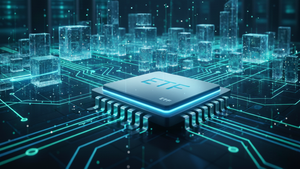
The technology sector of the S&P 500 is currently experiencing a robust surge, acting as a primary catalyst for broader market gains as of October 15, 2025. This powerful momentum is largely fueled by the relentless pursuit of Artificial Intelligence (AI) innovation and massive investments in data center infrastructure by industry giants. Companies like Advanced Micro Devices (NASDAQ: AMD) and ASML Holding N.V. (NASDAQ: ASML) are leading the charge with impressive stock performances, while Meta Platforms (NASDAQ: META) and Amazon (NASDAQ: AMZN) are pouring billions into solidifying their AI and cloud computing dominance.
This period marks a pivotal moment for the tech industry, underscoring the profound impact of AI on corporate strategies and market valuations. The sustained capital expenditures in AI infrastructure are not just driving revenue for chipmakers and equipment suppliers but are also reshaping the competitive landscape for cloud service providers and social media behemoths. Investors are keenly watching as these strategic shifts promise to redefine efficiency, innovation, and profitability across the entire technological ecosystem.
Unpacking the Surge: AI-Driven Performance and Billions in Infrastructure
The current market enthusiasm stems from several significant developments within the technology sector. Advanced Micro Devices (NASDAQ: AMD) has been a standout performer, with its stock price leaping between 8.7% and 9.4% on October 15, 2025, making it one of the S&P 500's top gainers. This remarkable ascent is directly attributable to heightened revenue visibility for its Artificial Intelligence Graphics Processing Units (AI GPUs). Recent strategic partnerships, including a significant collaboration with OpenAI and a deal to supply chips to Oracle (NYSE: ORCL), have substantially bolstered AMD's position in the burgeoning AI chip market. Analysts have responded by aggressively raising price targets, with HSBC, for instance, elevating its target from $185.00 to an impressive $310.00, reiterating a "Buy" rating and signaling strong confidence in the company's future.
ASML Holding N.V. (NASDAQ: ASML), a critical supplier of photolithography equipment for semiconductor manufacturing, also demonstrated positive momentum, with its stock rising approximately 3% on the same day. This followed the release of its third-quarter 2025 results, which, despite some mixed analyst views on near-term growth, showcased robust order bookings, particularly for its cutting-edge Extreme Ultraviolet (EUV) systems. The company reaffirmed its full-year 2025 sales growth target of roughly 15% year-over-year and projected gross margins near 52%, further anticipating 2026 net sales to surpass 2025 figures. Bank of America (NYSE: BAC) notably raised ASML's price target to $1,134, maintaining a "Buy" rating, citing that the Q3 results effectively addressed concerns regarding customer concentration and highlighted strong EUV demand.
Concurrently, tech giants Meta Platforms (NASDAQ: META) and Amazon (NASDAQ: AMZN) are making colossal investments to build out their AI and data center capabilities. On October 15, 2025, Meta announced a commitment of over $1.5 billion to construct a new AI-optimized data center in El Paso, Texas. This facility, designed to support Meta's expanding AI workloads, including sophisticated large language models and its ambitious pursuit of "superintelligence," is projected to scale to one gigawatt. This investment is part of Meta's broader strategy to allocate "hundreds of billions of dollars" to AI infrastructure, bringing its total investment in Texas alone to over $10 billion. Similarly, Amazon plans to funnel more than $100 billion in capital expenditures in 2025, primarily into expanding its AI and cloud data centers for Amazon Web Services (AWS). CEO Andy Jassy has indicated that these AI investments are expected to yield significant efficiency gains across the company, potentially leading to a reduction in its total corporate workforce. Amazon's initiatives include developing proprietary large language models (Nova AI models) and custom-built AI processors (Trainium AI chips), alongside its Bedrock marketplace for third-party AI models and an AI-powered shopping assistant. These substantial capital outlays by major cloud service providers, including Amazon, Alphabet (NASDAQ: GOOGL), Meta, and Microsoft (NASDAQ: MSFT), are collectively projected to exceed $360 billion in 2025, with the vast majority directed towards powering data centers.
Strategic Beneficiaries and Emerging Challenges in the AI Era
The current technological landscape clearly delineates a set of companies poised to be significant winners, alongside others facing new competitive pressures. Advanced Micro Devices (NASDAQ: AMD) stands as a prime beneficiary of the AI boom. Its strategic pivot towards high-performance computing and AI GPUs, evidenced by its partnerships with OpenAI and Oracle (NYSE: ORCL), positions it to capture a substantial share of the rapidly expanding market for AI accelerators. The increasing demand for powerful chips to train and deploy large language models translates directly into higher revenue and market share for AMD, allowing it to compete more effectively with Nvidia (NASDAQ: NVDA), the current market leader in AI GPUs.
ASML Holding N.V. (NASDAQ: ASML), as the sole producer of advanced EUV lithography machines essential for manufacturing the most sophisticated semiconductors, is in an indispensable position. The escalating global demand for high-performance chips, driven by AI and data center expansion, directly fuels the need for ASML's equipment. As chipmakers like Taiwan Semiconductor Manufacturing Company (NYSE: TSM), Intel (NASDAQ: INTC), and Samsung Foundry race to produce next-generation processors, ASML's order books are expected to swell, ensuring sustained growth and profitability. Its unique technological advantage effectively insulates it from direct competition in this critical niche.
Meta Platforms (NASDAQ: META) and Amazon (NASDAQ: AMZN) are strategically investing to maintain and extend their leadership in the digital economy. Meta's massive data center investments are crucial for developing and deploying its AI capabilities across its vast social media ecosystem, enhancing user experience, advertising targeting, and eventually powering its metaverse ambitions. For Amazon, these investments reinforce Amazon Web Services (AWS) as the dominant cloud provider. By developing proprietary AI models and chips, Amazon aims to offer superior, cost-effective AI services to its enterprise customers, further entrenching AWS as the go-to platform for AI development and deployment. This proactive stance ensures they remain at the forefront of AI innovation, potentially creating new revenue streams and optimizing existing operations.
Conversely, companies that fail to adequately invest in AI research, development, and infrastructure risk falling behind. Smaller cloud providers or traditional enterprise software companies that do not offer competitive AI-as-a-service solutions may find themselves losing market share to the tech giants. Additionally, chip manufacturers without a strong AI GPU offering could see their market relevance diminish as the industry increasingly prioritizes AI-specific hardware. The high barrier to entry for developing cutting-edge AI chips and building massive data centers also poses a significant challenge for new entrants, solidifying the positions of established players.
The Broader AI Revolution and Its Far-Reaching Implications
These developments are not isolated events but rather integral components of a broader, transformative AI revolution sweeping across industries. The insatiable demand for computational power, epitomized by the robust performance of AMD (NASDAQ: AMD) and ASML (NASDAQ: ASML) and the expansive investments by Meta Platforms (NASDAQ: META) and Amazon (NASDAQ: AMZN), signifies a fundamental shift in technological priorities. This trend extends beyond the immediate tech sector, indicating that AI is no longer a niche technology but a core driver of economic growth and competitive advantage. It aligns with the overarching industry trend of hyper-scalability in cloud computing, where the ability to process vast amounts of data at unprecedented speeds becomes paramount.
The ripple effects of these investments are profound and multi-faceted. On the supply side, the increased demand for advanced semiconductors will inevitably benefit other players in the semiconductor ecosystem, including materials suppliers, equipment manufacturers beyond ASML, and packaging and testing services. However, it also places immense pressure on the global supply chain, raising concerns about potential bottlenecks and geopolitical risks, especially given the concentration of advanced chip manufacturing in specific regions. For competitors, particularly those in the cloud computing space, the aggressive AI infrastructure build-out by Amazon Web Services (AWS) and Microsoft Azure (NASDAQ: MSFT) necessitates a rapid acceleration of their own AI strategies to avoid being outmaneuvered. Companies like Google Cloud (NASDAQ: GOOGL) are also heavily investing, showcasing a fierce battle for AI dominance among the hyperscalers.
Regulatory and policy implications are also emerging as a critical consideration. The sheer scale of investments by a few dominant tech companies in AI raises potential antitrust concerns, particularly regarding market concentration and data control. Governments globally are increasingly scrutinizing the ethical implications of AI, data privacy, and the potential for AI-driven job displacement, which could lead to new regulations impacting how these companies develop and deploy AI technologies. Historically, major technological shifts, such as the internet boom or the rise of mobile computing, have often led to periods of intense investment, rapid innovation, and subsequent regulatory adjustments, suggesting that the current AI wave will follow a similar trajectory. The race for AI supremacy also has national security implications, prompting governments to invest in domestic AI capabilities and secure critical semiconductor supply chains.
The Road Ahead: Navigating Opportunities and Challenges
Looking ahead, the short-term outlook for the S&P 500 technology sector, particularly for AI-centric companies, remains exceptionally strong. The momentum generated by robust demand for AI GPUs and the continuous expansion of data center infrastructure is expected to sustain positive performance for companies like Advanced Micro Devices (NASDAQ: AMD) and ASML Holding N.V. (NASDAQ: ASML) through late 2025 and into 2026. Meta Platforms (NASDAQ: META) and Amazon (NASDAQ: AMZN) will continue to aggressively deploy their newfound AI capabilities, which could translate into enhanced product offerings, more efficient operations, and potentially new revenue streams in the near future.
In the long term, the trajectory of these companies and the broader sector will depend on several critical factors. Strategic pivots will be essential as AI technology matures and new applications emerge. Companies will need to adapt their business models to fully leverage AI, moving beyond mere infrastructure provision to offering highly specialized AI-powered services and solutions. The "AI-as-a-service" market is expected to grow exponentially, creating opportunities for both established players and nimble startups. Challenges, however, include the escalating costs of AI development, the ongoing talent war for AI specialists, and the potential for regulatory hurdles that could impact innovation or market access.
Potential scenarios and outcomes vary. In an optimistic scenario, the current wave of investment leads to a virtuous cycle of innovation, driving unprecedented productivity gains across the economy, with tech leaders like AMD, ASML, Meta, and Amazon cementing their positions as trillion-dollar enterprises. A more conservative scenario might see a moderation in growth as the initial build-out phase for AI infrastructure slows, or as geopolitical tensions impact global supply chains for critical components. The emergence of new, disruptive AI architectures or unforeseen technological breakthroughs could also shift the competitive landscape, requiring continuous adaptation from all players.
A New Epoch in Technology: Investors on High Alert
In summary, the S&P 500 technology sector is currently experiencing an exhilarating period of growth, predominantly fueled by the transformative power of Artificial Intelligence. The exceptional performance of companies like Advanced Micro Devices (NASDAQ: AMD) and ASML Holding N.V. (NASDAQ: ASML), coupled with the monumental AI and data center investments by Meta Platforms (NASDAQ: META) and Amazon (NASDAQ: AMZN), underscores a fundamental reorientation of the tech industry towards AI-driven innovation. These strategic moves are not merely enhancing corporate valuations but are laying the groundwork for a new epoch of technological advancement, promising to reshape how businesses operate and how consumers interact with digital services.
Moving forward, the market will continue to be heavily influenced by the pace of AI development and deployment. The "AI arms race" among tech giants is expected to intensify, driving further capital expenditures and fostering innovation in semiconductor design, cloud infrastructure, and AI software. The lasting impact of this period will likely be a more efficient, intelligent, and interconnected global economy, with AI embedded in nearly every facet of digital life.
Investors should closely watch several key indicators in the coming months. These include quarterly earnings reports from leading AI chipmakers and cloud providers, particularly focusing on their AI-specific revenue and capital expenditure guidance. Updates on new AI product launches, strategic partnerships, and advancements in AI model capabilities will also be crucial. Furthermore, any shifts in regulatory policy regarding AI, data privacy, or antitrust could significantly influence market sentiment and corporate strategies. The current trajectory suggests that the technology sector, propelled by AI, will remain a dominant force in the financial markets for the foreseeable future, demanding vigilant observation and strategic positioning from all stakeholders.
This content is intended for informational purposes only and is not financial advice





